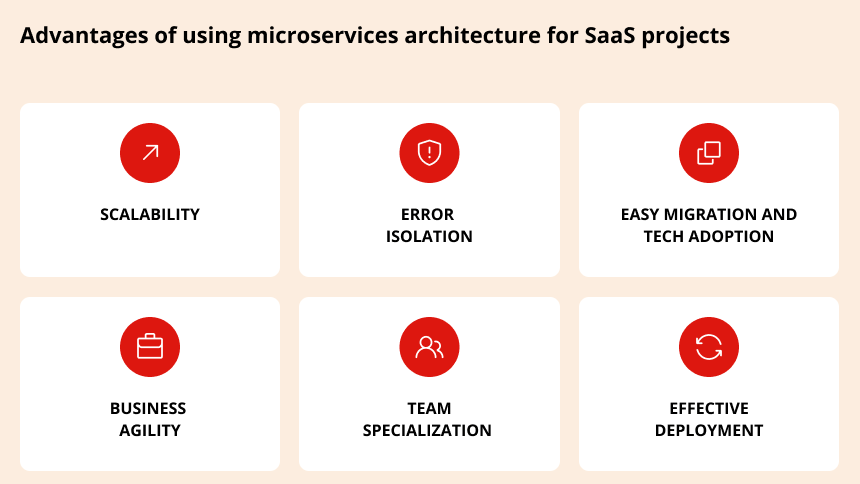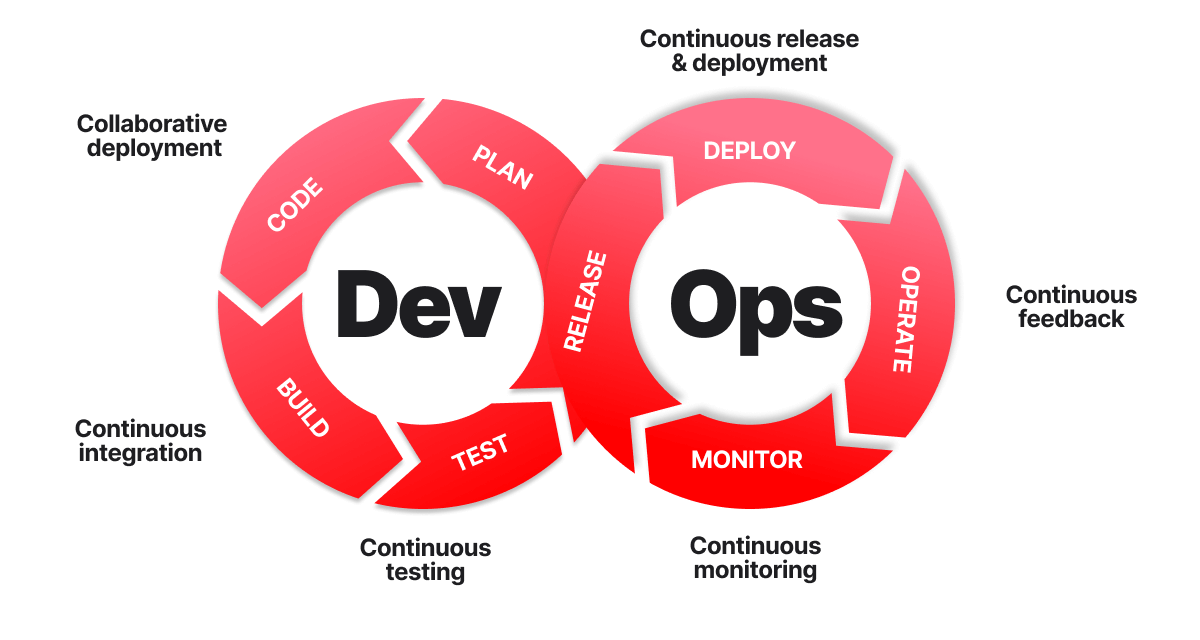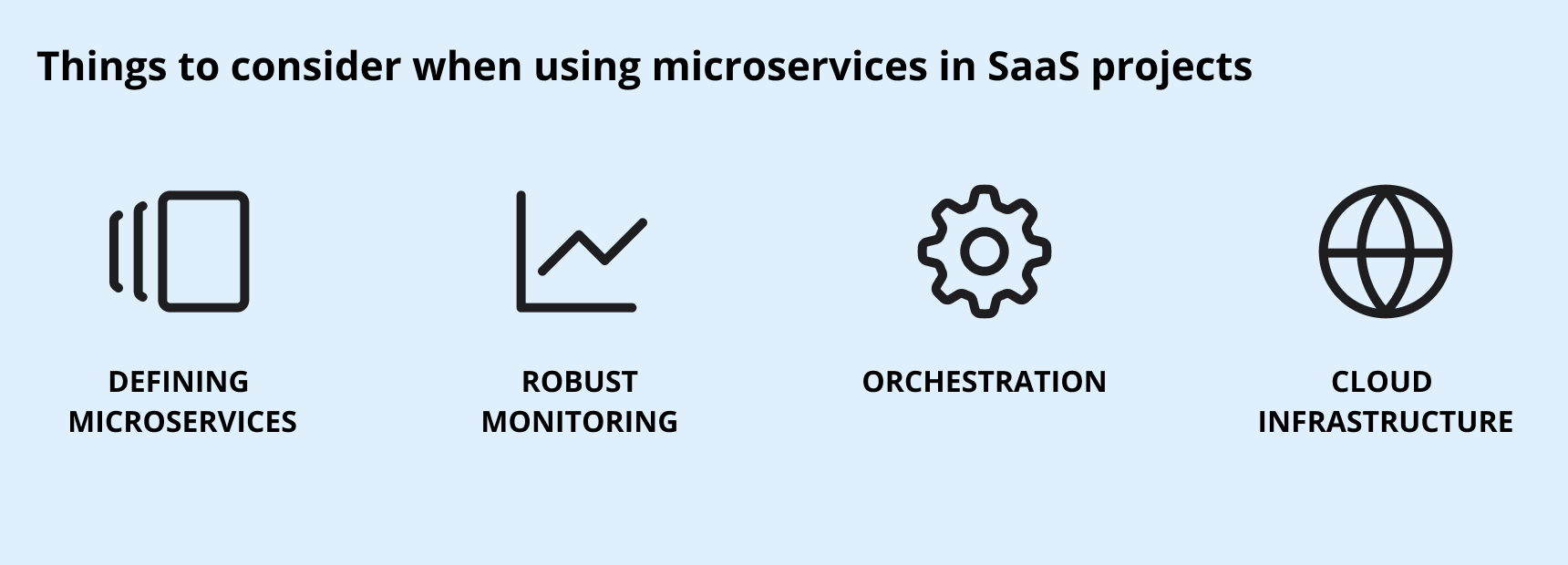Why Use Microservices Architecture for SaaS Application Development
If you want to build a resilient SaaS or need to refactor your software that has grown too large and too hard to manage, you probably consider microservices for the job. And for a good reason. SaaS and microservices are made for each other. In this post, you will find our why.
Read on to learn:
- Why microservices approach is so common in modern applications.
- What makes microservices a good match for SaaS development.
- What to consider before opting for SaaS microservices architecture.
- How we can help you leverage microservices for your SaaS.
Microservices architecture is an API-driven approach to design and build software as a collection of individual services (microservices). Each microservice is dedicated to a specific function and has its own business logic, database, and technology stack. For example, User Account, Catalog, Shopping Cart, Order, Discount, and Shipping are the microservices of an eCommerce application.
But what makes microservices SaaS a power couple?
Unlike traditional monolithic applications built and deployed as one undivided unit, microservices applications consist of small, loosely coupled modules. They are faster and easier to scale, build up, and modernize. For SaaS companies, it means much-needed flexibility to quickly adapt to changing market needs and future-proof their software.
It explains the growing popularity of this approach. In fact, some of the most successful SaaS products you may be using every day are built with microservices. When you access your documents on Dropbox, choose your Spotify playlist, or log in to your Netflix account, you use microservices-based SaaS.
Microservices adoption is worth the expense and effort, according to 87% of surveyed developers and IT executives. Source: IBM.
Let’s break down the benefits of microservices architecture for SaaS projects in detail and see if this approach is a good match for your application.

Scalability
Scalability is an essential requirement referring to how well your software can handle the increasing number of users and requests without slowing down. If you aim for growth, your SaaS should be able to effectively scale without wasting your resources. Microservices architecture helps you do that, and more.
Precise cost-effective scaling is one of the key reasons to choose microservices for SaaS. Each service in microservices can be scaled individually and unevenly. So you can allocate resources to specific services on demand without scaling up the entire system.
Error isolation (and traceability)
Isolation of services is one of the biggest benefits of microservices over monolithic architecture. High degree of autonomy between services enables better resilience. Errors in one part of the application won’t always impact and bring down the whole system. Tracing and troubleshooting is also usually faster in a modular system.
For SaaS-based product development, it means high reliability, stable performance, and lower risks of downtime (read: lower risk of losing customers).
Example: When building a fundraising platform for ThinkDonate, our solution architect chose a microservices approach to meet high security, scalability, and reliability requirements. We isolated business-critical services to minimize security risks and make sure the system could scale up without inflating infrastructure costs.

Easy migration and tech adoption
Tech stack evolution is one of the biggest challenges for growing SaaS solutions. Migrating to the latest frameworks and moving on from legacy applications without disrupting operations and gaining heavy technical debt require planning, resources, and time. The time that many SaaS companies don’t have due to the perpetual race for the market.
Unfortunately, embracing microservices architecture for SaaS won’t magically solve this problem. But it makes tech adoption and modernization a lot easier and more efficient. Because microservices approach is tech-agnostic — every service can have its own stack, data structure, and even a dedicated development team.
So you can hand-pick the best possible technologies for every task without worrying about compatibility. And you can prioritize business-critical services and gradually phase out from the aging stack based on your needs and budget. Or even experiment with trendy technologies without risks of compromising the rest of the system.
Business agility
Along with carte blanche in choosing technologies, using a microservices architecture for SaaS application development provides you with unparalleled business agility. Which you need to keep up with the dynamic market and meet customer needs.
Modular architecture and lightweight services speed up the overall development process. It’s easier to add new functionality, implement integrations, and build up individual services. So you can better align your development plan with changing business priorities, roll out new features faster than competitors, and allocate your resources to the most critical tasks at hand.
Team specialization
Another reason to choose microservices architecture for SaaS applications is effective team structure. Dividing your development resources into small service-oriented teams helps improve productivity and speed up development cycles thanks to stronger focus and acquired expertise. And you can scale each team on demand when certain modules get bigger and require more resources.
Example: Lodgify has grown from a start-up into one of the leading SaaS for vacation rental management. Since 2020, we have been helping them scale up their development resources by adding senior .NET engineers to small development teams specialized in certain modules of their solution. This targeted approach enabled Lodgify to get extra hands in the areas they needed the most, fast and cost-effectively.
“Working with Digiteum has helped us immensely in scaling our development resources while ensuring high-quality deliveries.” Oleksandr Marchenko, VP of Engineering.
Effective deployment
Modern engineering and deployment practices work well with microservices, promoting frequent and smooth releases and effective software development lifecycle. Every service in microservices is developed, tested, and deployed independently. So engineers can integrate their code changes and release new features faster.
Opting for microservices-based architecture for SaaS application development facilitates the adoption of DevOps best practices and CI/CD tools for automated testing and deployment. This leads to rapid releases, stable performance, and better control over a complex SaaS infrastructure.

Future-proof your SaaS with microservices
Build a scalable, high-performing SaaS that seamlessly grows with your business and customer base.
MICROSERVICES SERVICES
Defining microservices
This is one of the most important tasks to solve at the start of your journey. Some applications are easier to break down into smaller components based on distinctive business functions and use cases. Others – not so much. And of course, there is no one-fits-it-all solution, as every organization has its own context, requirements, and goals.
To define microservices for SaaS application development, you have to consider a wide range of technical and business factors. This includes your process, scalability requirements, communication between services, team structure, and more. The goal is to create services that are not too small to create unnecessary complexity but not too big to slow down deployment and scaling.
Robust monitoring
A multicomponent distributed system with myriad connection points can’t exist without robust monitoring. Errors may go unnoticed. DevOps approach solves the problem of managing complex microservices environment by setting up ongoing monitoring of infrastructure, performance, and resource use.
Orchestration
Along with monitoring, microservices-based SaaS product development requires proper orchestration. Otherwise, a complex system consisting of many smaller parts can easily get out of hand. Containers and orchestration tools like Docker and Kubernetes help create and manage distributed heterogeneous systems enabling effective deployment and scaling.
Cloud infrastructure
SaaS and microservices are associated with the cloud as an enabler technology providing scalability, flexibility, and a cost-effective pay-per-use pricing strategy. SaaS companies leverage the cloud to optimize the use of resources, seamlessly scale up on demand, and spare themselves from the challenge of building and managing their own infrastructure.
Similarly, the benefits of microservices are best manifested when applications are hosted in the cloud. All this makes SaaS, microservices, and cloud a powerful trio. So if you consider microservices architecture for SaaS application development, look into managed cloud services as an optimal infrastructure solution.
If you want to leverage microservices for your new SaaS application or plan to modernize legacy application and migrate to modular architecture, we can help. At Digiteum, we help companies of various sizes, from enterprise brands like Adorama and Oxford University Press to visionary startups like ThinkDonate, embrace change and future-proof their businesses with a modern approach to software architecture and scalable development resources. Our SaaS and microservices experience includes:
- On-demand team augmentation for a Spanish travel tech SaaS company. Since 2020, we have been helping the company effectively scale their development resources and supporting the development of their microservices-based SaaS applications. Read the full success story…
- Continuous migration from monolith to microservices and cloud for a leading photo print service provider in the US. The client runs a high-load web system comprising dozens of B2B and B2C services provided to millions of users online. Our dedicated team has been supporting their tech evolution since 2010, ensuring that their software seamlessly grows with their business and provides superior customer experience. Read the full success story…
- Dedicated development team for a diagnostic data analytics company in the UK. The client had a goal to develop a precision medicine SaaS on a tight deadline and needed a reliable partner to quickly put together a cross-functional team. We joined the project with 13 senior specialists to implement SaaS microservices architecture, build compiler ETL data pipelines, and deliver the solution in a record 8 months. Read the full success story…
Adopt microservices with confidence
Plan, implement, and scale your microservices SaaS project with an experienced agile team.
HIRE MICROSERVICES EXPERTSQuick wrap-up
- Microservices enable precise cost-effective scaling, agility, fast release cycles, and robust performance, vital for SaaS products.
- When choosing microservices for your SaaS project, consider the importance of adopting effective deployment, orchestration, infrastructure monitoring and management practices.







